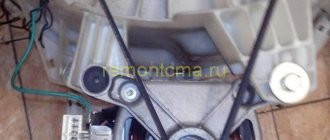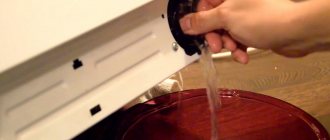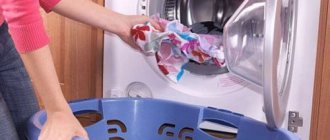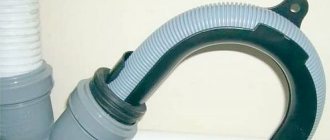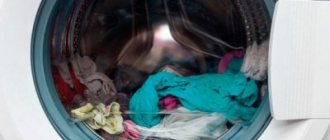Candy washing machines are well-proven equipment that rarely cause problems.
But during long-term operation, machine parts gradually wear out, and the machine may begin to work intermittently.
If the machine, for example, stops spinning clothes, its operation can no longer be called normal. Why the Kandy washing machine does not spin clothes and what to do about it, we will tell you further.
What is the reason that the spin does not work?
There are several reasons for the lack of spin, not related to breakdown. These include:
- settings failure;
- disabling the spin cycle during the previous wash;
- uneven distribution of laundry in the drum;
- Drain filter clogged.
The first step is to check the spin mode settings. Perhaps it was turned off earlier and forgotten about it. Or for some reason the spin speed settings may have changed. The spin function must be turned on, and if it is on, increase the number of revolutions.
If the laundry in the drum is unevenly distributed, it becomes unbalanced. The machine evaluates this as a violation of the operating process and stops washing. As a result, the laundry does not go through the spinning stage and remains wet. If there is an imbalance in the drum, you need to turn off the machine, manually distribute the laundry, and start the wash.
It is recommended to clean the drain filter in your car at least twice a month . If this is not done, over time, the clog in the filter begins to interfere with the drainage of water. If the clog is severe, some of the water remains in the drum, so the laundry remains wet.
If the machine is set up correctly and its drain filter is cleaned, but there is still no spin, you need to look for the breakdown that led to this.
The most common causes are the following breakdowns:
- electronic controller malfunction;
- failure of the speed control sensor;
- drain pump failure.
Breakdown or error?
When faced with the problem of a lack of spin in the machine, you must first eliminate all user errors. So to speak, make sure that the machine is really broken. The fact is that the laundry will remain wet if a mode has been selected for which spinning is not provided or it takes place at low speeds. As a result, it seems to you that the machine has stopped spinning well.
In addition, some users turn off the spin cycle and then forget to turn it on. Another common reason when the washing machine does not spin is improper distribution of the laundry. This happens when there is too little laundry in the drum, or it is bulky, but at the same time very light, for example, organza curtains.
In this case, you need to check whether the machine spins in principle by turning on the spin function separately and placing cotton products, for example, towels, in the drum.
The reason for poor spinning or lack thereof may be a clogged drain filter. It is enough to unscrew the filter located at the bottom of the machine and wash it. When unscrewing the part, be prepared for water pouring out of the hole, so prepare a good large rag and place a flat container.
How to identify the problem?
You will have to look for a breakdown by checking each node one by one. It’s better to start with the simplest thing – checking the pump.
water pump
It is necessary to place the car on its side and disconnect all pipes and wires from the pump. After this, the cover is removed from the pump. Now you can check its status.
There may be two options here - the impeller is clogged or the pump electrics are burnt out . First you need to clean the impeller. It should rotate freely.
After this, use a multimeter to check the presence of resistance in the pump. If it is not there, then you need to buy and install a new pump.
After checking or repairing the pump, during reassembly, it is recommended to thoroughly rinse the pipes. This is done using a soft brush. You need to remove all accumulated mucus and dirt. This kind of prevention not only increases the wear resistance of the machine, but also eliminates unpleasant odors.
Tachometer
Let's say that checking the pump showed that everything is fine with it, but there is still no spin. The next action should be to check the tachometer . It is installed on the engine rotor. Its function is to control engine speed. You can get to it by completely removing the rear wall of the car or opening the service hatch in it. The engine is located under the tank, the tachometer is on the shaft.
To check, you need to remove the engine. First, the drive belt is released, then the mount of the motor itself is removed. All wires are disconnected from the sensor. Next, it is checked for resistance, which should be 60 Ohms.
If the resistance indicator is normal, before reassembling the machine you need to make sure that the bolt holding the tachometer is well tightened - the correct operation of the device depends on this.
Control module
Malfunction of the control unit is the most unpleasant option . If the verification procedures described above can be performed independently, then it is better not to touch the control module, but to immediately call a technician.
But if you have basic skills in working with boards, you can carefully test all available controllers one by one with a multimeter. This must be done without removing the module or disconnecting anything. The cost of incorrect reverse connection may be replacing the module with a new one.
It's easier to test controllers by simply testing them all. But you can do this using a pre-downloaded scheme. If the problem is not in the controller, but, for example, with some semiconductor part, you won’t be able to find it without a diagram.
The washing machine does not spin clothes: main causes and troubleshooting
Before you get upset, you need to make sure that all the settings on the display are set correctly. The function may simply not be enabled.
The spin icon on equipment from any company is depicted in the form of a twisted spiral. The difference is in the location of the element on the board. In some models, the final stage is combined with the rinsing mode.
Additionally, you need to correctly set the speed on the panel. The range varies from 400 to 1800. The optimal value is up to 1200. Above that, there is a risk of damaging the fabric.
For delicate washing, the spin mode is simply not provided. The function runs separately, after the main stage.
In the case when the control panel is programmed correctly, and the washing machine does not spin, it’s time to move on to searching for significant sources of the problem.
The main factors leading to spin failure include:
- non-compliance with the instructions for loading laundry;
- damage or failure of the motor;
- pressostat malfunction;
- malfunction of the tachometer;
- clogged drainage device.
Each specific cause and ways to correct it must be considered separately.
Washing machine overload
Loading a large amount of laundry with small tank volumes is the most important and common mistake when washing. Improper operation is typical for machines with a narrow drum type.
In models with washing standards of 3-3.5 kg, with strong overload at high speeds, an imbalance occurs, leading to the system stopping. A similar situation occurs when things are distributed incorrectly.
How to solve a problem:
- Remove excess clothing from the machine.
- Distribute the remaining laundry evenly.
- Restart the device.
Engine faults
If the mechanism is damaged, it may remain operational during washing, but fail when switching to spinning. Disturbances in the operation of the unit occur due to malfunctions of the coils and wear of the electric brushes.
Steps to find and resolve problems:
- Remove the rear part of the housing and remove the engine.
- Remove the graphite brushes.
- If elements are visible, replace them.
- Check the windings for short circuits and test them with a multimeter.
Self-repair of a non-working coil is not possible.
The water level sensor is broken
The task of the device is to transmit signals about the amount of liquid in the tank to the controller. In most machines, the pressure switch is located on the top of the side wall.
Functional disruption occurs when the sensor burns out or accumulates dirt and oxide. Before proceeding to unscrew the part, the washing machine must be disconnected from the voltage.
Actions to recognize and correct the failure:
- Disconnect the pressure pipes and rinse.
- If oxidation is visually detected on the connector, clean it.
- Install a silicone tube onto the fitting and blow through it. The absence of a characteristic click indicates a relay malfunction.
- Purchase a new device and install it in the same order.
The problem is in the tachometer
The mechanism is designed to control the rotation of the drum element when the washing machine is operating. If there is a malfunction, the system incorrectly counts revolutions per minute and the laundry spin mode is disrupted.
This type of breakdown occurs infrequently. It occurs when equipment is used systematically and too intensively. The tachometer is located under a cover at the end of the electric motor, so the problem may also be a loose fastening or loose contacts.
Checking the expected factors will require a number of actions:
- Remove the engine.
- Check wiring.
- Inspect the inside of the outer ring of the device for damage.
- Strengthen and fix the reel.
- Assemble the elements into place.
- Restart the program.
Drain pump system is faulty
The main function of the pump is to monitor the water level at each washing stage. Failure of the mechanism leads to stagnation of the waste liquid and the spinning of the washed clothes does not take place.
I can identify two reasons for the breakdown. The first is that the electrical module is broken. In this situation, only contacting specialists will help. The second is related to the technical part. When washing woolen items regularly, small parts accidentally get into the pump and become clogged. Checking for blockages should be carried out regularly.
If the inside of the pump is heavily contaminated, the system shuts down prematurely, periodically the mode fails, and the drain is accompanied by a creaking or other uncharacteristic sounds.
Consecutive actions:
- Remove the coarse filter, remove dirt and debris.
- Inspect the impeller, clean it, secure it tightly.
- Rinse the drain hose under running water and remove any kinks when reinstalling.
How to fix a Candy automatic washing machine?
Any identified malfunction must be corrected correctly.
Electronic board
The module can be removed and taken separately to a service center. This is done in the following way:
The machine is disconnected from the power supply.- The program selector knob is fixed in the off position with tape.
- The screws on the top panel are unscrewed.
- Remove the top cover.
- Remove the dispenser body.
- Pull out and remove the side panels.
- Unscrew the screws in the front corners of the case.
- The plastic clips holding the front panel are worn out and pressed out.
- Disconnect the latches securing the board.
- Take several pictures of the position of the connectors.
Although the panel is fairly easy to remove, it is difficult to reattach. To return all connectors to their places, photos are taken, which are mentioned in the last paragraph of the instructions. But this does not give a 100% guarantee that all reverse connections will be successful.
Therefore, experts advise not to touch the module, but to call a technician to your home . In this case, he will be able to conduct a full diagnosis and inspection of all elements of the machine, repair all faulty elements, and, most importantly, start the machine and make sure it is in full working order.
Repairing the control module of a Kandy washing machine, video instructions:
Drain pump
Machines equipped with a self-diagnosis system display an error code on the display. The code can be deciphered using the fault table for a specific brand. In this case, we will assume that the pump was physically removed from the car. As a result, all blockages have been removed, contacts and connections have been checked. And testing the pump electronics showed that the part needed to be replaced.
In this process, the most important thing is to buy exactly the same pump. To do this you need to know the car model. You need to install high-quality branded spare parts. You can buy a pump for any model of washing machine in a large specialized store or through a large specialized website.
The new part is installed in place of the old one . For greater reliability, during the process of disassembling and dismantling a broken pump, you can take several photos, and then use them to verify the correct installation.
Tachogenerator
The tachometer is easily removed. But to avoid errors in installing a new part, it is also better to take several pictures when dismantling it.
The new part must match the car model. After installing the tachometer, it must be checked for resistance .
If the multimeter does not register resistance, you need to check the reliability of the wire connections. The bolt holding the sensor must be tightened firmly.
What to do if a malfunction is detected?
The reason for the failure of the washing machine to spin clothes should be looked for first of all in the pump. Its dismantling using Kandy technology and installation is carried out through the bottom of the unit.
Household appliances are laid on their sides, a blanket is first laid down so as not to scratch the body. All electrical wires and connected pipes secured with mounting clamps are disconnected from the pump.
On a dismantled pump, first remove the housing cover to check the functionality of the impeller. If it is not clogged with debris and hair, and rotates easily, then we proceed to check the electrical circuit of the pump, measuring the resistance of the parts with a multimeter. If the pump burns out, it can be repaired in one way - by completely replacing it with an analogue corresponding to the model.
After the pump, you should check the tachometer installed on the electric motor. To do this, open the service hatch located on the rear panel of the housing part, or the entire wall is removed completely. An electric motor is located at the bottom of the tank, and a tachometer is located on its shaft. First you will have to remove the drive belt from the motor and pulley, then disconnect the fasteners and remove the motor.
All that remains is to disconnect the electrical wiring from the sensor and measure the resistance readings, which normally should vary within 60 ohms. Pay special attention to the bolt securing the sensor. It should not move, otherwise the device begins to produce unreliable data.
As a rule, the big problem in a Kandy washing machine is a breakdown of the module responsible for controlling the unit. This electronic part of the machine is quite difficult to check, especially if you do not have the appropriate skills. In this case, it is recommended to invite a service center specialist to help, who will perform diagnostics and determine the malfunction. Remember that repairing such an element yourself can result in serious financial expenses.
If you are familiar with working with electronic printed circuit boards, you can carefully check each controller for functionality using a multimeter. One of the elements you are checking is responsible for spinning the laundry. Some people pre-download the board diagram to install the parts and determine their areas of responsibility, but the “poke-and-jaw” method greatly simplifies the task. True, it gives a positive result if the fault lies in the controller. But if there are problems with a track or another semiconductor, look for a circuit.
Call the master
If the Kandy washing machine has stopped spinning clothes, you need to call a qualified technician to perform complex repair work. Nowadays it is easy to find a specialist via the Internet. But in order not to encounter scammers or irresponsible, inexperienced repairmen, before calling a repairman, you should check reviews about his company on an independent website.
The final cost, including a specialist’s visit to the customer’s home, diagnostics, repairs, dismantling and installation of components, must be agreed upon immediately.
The cost of the specialist’s services depends on:
- region,
- scale of the settlement,
- pricing policy of a specific service center,
- and, of course, on the type of repair.
So, some companies charge a certain cost for calling a technician. In other services, the call and diagnosis are free, and payment is only for certain repair operations performed. Built-in equipment is dismantled and installed back, usually at an additional cost.
Replacing the drain pump can cost the owner 1,500 - 2,500 rubles. The tachometer can be replaced for 1-2 thousand rubles. Repair of the control module will depend on the type of failure, and will cost at least 2 thousand.
Troubleshooting Methods
The main reason is a malfunction of the filter; you should not try to unscrew it yourself, so as not to increase the cost of repair work. It is necessary to invite a specialist who will remove the KANDY drain filter, disassemble the snail and clean the part from the debris accumulated there. Often the CANDY washing machine does not drain water due to clogged internal pipes that provide connection to the snail.
A breakdown of the control unit can lead to such dysfunction, due to which there is no voltage that should be transmitted to the pump. Naturally, in such a situation the drain does not work, and only an experienced specialist can eliminate the defect.
There are many modifications of cars of this brand, each of them has its own technical features; naturally, repairs should be made taking these into account. For example, some modifications have a filter blocking, for which a special screw is used. In this case, the washing machine should only be repaired by specialists, since it is impossible to remove the filter without disassembling the machine.
When the machine does not drain well, the first thing to do is always clean the filter by putting it back in place; twisting should be done without distortions to avoid leakage during washing. This is precisely one of the reasons why it is better to immediately turn to a professional without doing anything on your own. If your CANDY washing machine does not drain water, call service!
How to use the Spin mode
There are no difficulties in using the function. Even an “inexperienced” user can handle this. The procedure involves the following sequence of actions:
- We put clothes in the SMA drum. The volume of things will depend on the maximum allowable load of a particular washing machine model. Overloading of linen, as well as its shortage, should be avoided. Because this may cause an error in the software.
- Close the hatch door.
- Turn the toggle switch to the “Spin” icon.
- Using the handle or pressing the button with the corresponding inscription, we set the drum rotation speed (revolutions per minute).
Let us remind you! The selection may be automatically limited depending on which program was initially selected. - We start the program by pressing the “Start/Pause” button.
Most SMAs (Bosch, Samsung, Candy and others) have the ability to change the drum rotation speed not only before starting the program, but also in the middle of the cycle without stopping it.
Design features of the automatic machine
Like other washing machines, LG machines have a body that includes back and front panels, a lid and a bottom. Any device has a hatch. The most popular and in demand are front-facing models, in which the door is located on the front of the panel. Less common are products with a top hatch.
Next to the panel there is a tray for loading powder and conditioner (also called a powder receiver). The bottom of the hull is equipped with a technical hatch with a garbage filter and an emergency hose. The automatic machine also has a cord for operation from a 220 V network and 2 hoses.
The internal structure of the equipment is much more complex. It includes electronics (sensors, wiring), complex mechanisms, gaskets. Let's look at the main elements of an automatic machine.
- Electronic board. This is the “brain” of the device, coordinating the functioning of the washing unit.
- Inlet valve. Visually it is a plastic box with 1 or 2 coils. When voltage is applied, the membrane opens, due to which water is drawn into the drum.
- Motor. Recently, LG has been releasing models equipped with a direct drive motor. Such motors do not have a belt drive. Older models have commutator motors - they have a belt that stretches during intensive use and often falls off or breaks.
- heating element. With the help of this element, the water in the tank is heated to the set temperature provided by the program.
- A pump or pump designed to pump water out of a tank.
- Shock-absorbing elements that reduce vibration levels when washing and spinning clothes.
The design of the washing machine includes various cuffs, hoses and pipes.
Regardless of the appearance of the models, automatic machines may not wring things out for the same reasons. Here are the most common ones.
The machine stops during the spin process
Unlike the case described above, the machine freezing during the washing process is almost always associated with hardware problems. Stopping can occur both during periods of rotation of the drum with water and laundry, and during spinning. There are several standard reasons for this problem.
- The drum balancing sensor is broken. This component is installed in almost all modern washing machines. It determines the uniform placement of laundry along the walls of the drum. If the control system does not receive the appropriate signal from the sensor, the machine simply stops. For example, it does not start spinning or rotating the drum to prevent mechanical damage due to vibration.
- Worn or damaged shock absorber unit. They stop performing their functions correctly. As a result, vibrations occur when the machine operates. Control sensors that monitor them initiate engine shutdown. This protects both the mechanics of the machine and the electronic control system.
- The tachometer is broken. There are magnets installed on the drum of the machine in the drive area. Their movement is monitored by a tachometer. If it is broken, the washer's electronics cannot correctly set the motor operating mode. As a result, the protection stops the spin cycle or terminates the program execution.
- The pressure switch is broken. The unit controls the water level. If it is broken or does not produce reliable data, the machine is not able to work normally. It does not recognize cases when there is water left in the drum, and cannot set the operating modes of the pump. Typically, the electronics stop the device before the spin process begins.
Electronic malfunctions, even those caused by the accumulation of dirt, are also dangerous. As a result, the machine either freezes or does not perform its functions correctly.
Testing the engine
The engine, tachogenerator and brushes will have to be viewed through the bottom. And since the pump was checked before, it means that the washing machine is lying in the desired position, on its side, and the drain pump and pipe are disconnected. Therefore, the next stage of diagnosis will be to disconnect the wiring from the motor, unscrew the bolts securing it and remove the element.
To easily pull out the engine, push it back, pull it down slightly, and then pull it towards you.
Having taken out the motor, find the Hall sensor on it. Outwardly it looks like a ring. Disconnect the part and test with a multimeter. If everything is fine with the tachogenerator, remove the electric brushes and inspect them. If there is obvious wear on the graphite rods, replace the pair.
If new brushes are not required, use a multimeter to check the resistance of the stator and rotor windings of the motor. Having identified a malfunction, you will have to decide what is more appropriate: replace the unit or buy a new machine.
Preventing breakdowns in washing machines
It is possible to anticipate the occurrence of problems associated with increased noise levels, strong vibrations, and lack of a spin function if you adhere to the basic recommendations for the care and operation of equipment.
Experts advise doing the following with washing machines:
- load the volume of things without exceeding that specified in the machine’s passport;
- check for foreign objects in pockets;
- use covers for washing small items;
- less often include programs that involve working at high speeds and using hot water;
- clean filters regularly;
- Use only high-quality detergents and water softeners for washing.
Proper care and high-quality prevention will prevent malfunctions in the operation of the machine. You can learn about the weaknesses of individual brands from user reviews
If problems are identified, it is necessary to diagnose the product and replace failed components for the correct operation of the machine.
Timely and correct replacement of parts will extend the life of the equipment and prevent more serious breakdowns.


